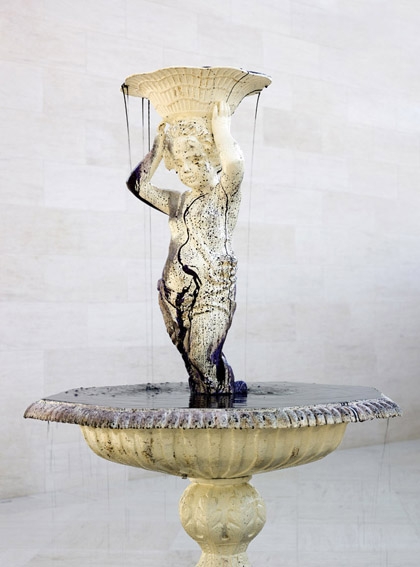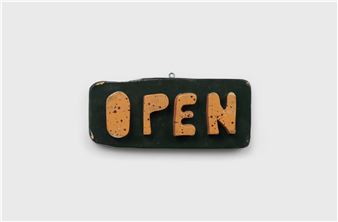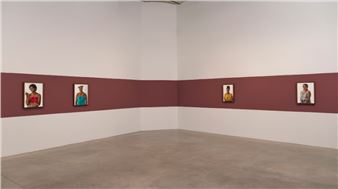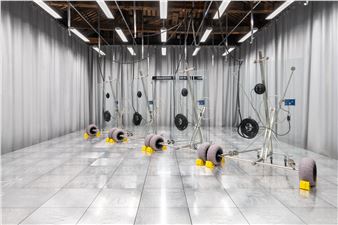Brave New World: From the Perspective of Mudam Collection
Every collection is a certain view of the world. When the subject is contemporary art, it reflects art and a world which are changing, in the process of developing, evolving. The more this view is sharp and alert, the more the collection tells of art and the world in all their richness and complexity.
A public contemporary art collection such as Mudam’s seeks out this richness and complexity. The collection is still young, begun a dozen years ago. But already the wide-ranging, pertinent views which have built it up can be observed, in this case that of Bernard Ceysson between 1996 and 1999, then that of Marie-Claude Beaud, in charge of the pre-opening campaign and the first director of Mudam, from 2000 to 2008. Because in a museum, views succeed one another and add together, meaning the collection’s direction and horizons change progressively, without ever forgetting its origins or hindering its progress. The collection is thus permanently sustained by past experiences and by works of art which have been acquired and, with the passing years, it becomes a double view: a continuous view of art and the world which are evolving before its very eyes and to which it is party, as well as a look at itself, a reflection on the whys and wherefores of its very existence and an examination of its own future.
The exhibition, Brave New World (From the perspective of Mudam Collection), is also a double view. One of these is the collection’s view of the world: what do the works of art tell us about the world in which we live and which we contribute, every day, to (de-)constructing, to (de-)forming, to (de-)thinking? What images do the artists send us of our faces, our dreams and our anguish? The viewer who lingers before a work of art and is confronted with the questions that it provokes in him can see a whole range of possible responses appear.
The other view is the collection’s view of itself: it devotes itself to show here, its originality, its pertinence, its multiplicity, its complexity, its opening up of the most diverse and the most current artistic practices. It also presents its (rare) weaknesses, which nevertheless contribute to giving it more body and life. And it displays freedom, independence, and sometimes courage, knowing that a public collection of contemporary art owes it to itself not to succumb to the effects of fashion, to the laws of the market, to the pressure of individual interests or to the visions of an exclusive world. Its greatest richness is to combine intuition and knowledge of recent developments in artistic practice, specific knowledge of the scientific discipline which is art history and responsibility vis-à-vis the most diverse public in our society.
But how can one put together and present the multiplicity of views without imposing a uniform reading? The method proposed here allows stories to be told through groups of works which form four fragmentary “episodes”, without frontiers, of an imaginary story whose title refers to the book by Aldous Huxley, Brave New World, published in 1932. Only the title and a few citations have been borrowed from the famous science-fiction novel which took a lucid and implacable, yet very ironic, view, on the world appearing before the eyes of the author. The collection is a humorous and tender invitation to invent more stories on the methods of intuitive reason. And the exhibition engages every viewer into making a personal and non linear reading of the works of art grouped into the “episodes” concerned with our faces, our artificiality, our territories, our dreams and our anguish, without having to consider these demarcations as strict and rigid attributions, most of the works of art being very suitable for a number of episodes. In this regard, it also echoes the idea of architect I. M. Pei, who did not want an obligatory route in his building.
Therefore, Brave New World presents a part of the Mudam Collection in this way. Other presentations will follow, in other forms, provoking other stories, because this exhibition cannot, very thankfully, show the whole collection, through lack of space of course, but also because to exhibit is to choose. And especially because the collection is continually, if slowly, growing, and it will continue to offer original views on art and the world from the very specific situation that is ours, in Luxembourg, at the beginning of the 21st century. The adventure continues.

Recommended for you
Every collection is a certain view of the world. When the subject is contemporary art, it reflects art and a world which are changing, in the process of developing, evolving. The more this view is sharp and alert, the more the collection tells of art and the world in all their richness and complexity.
A public contemporary art collection such as Mudam’s seeks out this richness and complexity. The collection is still young, begun a dozen years ago. But already the wide-ranging, pertinent views which have built it up can be observed, in this case that of Bernard Ceysson between 1996 and 1999, then that of Marie-Claude Beaud, in charge of the pre-opening campaign and the first director of Mudam, from 2000 to 2008. Because in a museum, views succeed one another and add together, meaning the collection’s direction and horizons change progressively, without ever forgetting its origins or hindering its progress. The collection is thus permanently sustained by past experiences and by works of art which have been acquired and, with the passing years, it becomes a double view: a continuous view of art and the world which are evolving before its very eyes and to which it is party, as well as a look at itself, a reflection on the whys and wherefores of its very existence and an examination of its own future.
The exhibition, Brave New World (From the perspective of Mudam Collection), is also a double view. One of these is the collection’s view of the world: what do the works of art tell us about the world in which we live and which we contribute, every day, to (de-)constructing, to (de-)forming, to (de-)thinking? What images do the artists send us of our faces, our dreams and our anguish? The viewer who lingers before a work of art and is confronted with the questions that it provokes in him can see a whole range of possible responses appear.
The other view is the collection’s view of itself: it devotes itself to show here, its originality, its pertinence, its multiplicity, its complexity, its opening up of the most diverse and the most current artistic practices. It also presents its (rare) weaknesses, which nevertheless contribute to giving it more body and life. And it displays freedom, independence, and sometimes courage, knowing that a public collection of contemporary art owes it to itself not to succumb to the effects of fashion, to the laws of the market, to the pressure of individual interests or to the visions of an exclusive world. Its greatest richness is to combine intuition and knowledge of recent developments in artistic practice, specific knowledge of the scientific discipline which is art history and responsibility vis-à-vis the most diverse public in our society.
But how can one put together and present the multiplicity of views without imposing a uniform reading? The method proposed here allows stories to be told through groups of works which form four fragmentary “episodes”, without frontiers, of an imaginary story whose title refers to the book by Aldous Huxley, Brave New World, published in 1932. Only the title and a few citations have been borrowed from the famous science-fiction novel which took a lucid and implacable, yet very ironic, view, on the world appearing before the eyes of the author. The collection is a humorous and tender invitation to invent more stories on the methods of intuitive reason. And the exhibition engages every viewer into making a personal and non linear reading of the works of art grouped into the “episodes” concerned with our faces, our artificiality, our territories, our dreams and our anguish, without having to consider these demarcations as strict and rigid attributions, most of the works of art being very suitable for a number of episodes. In this regard, it also echoes the idea of architect I. M. Pei, who did not want an obligatory route in his building.
Therefore, Brave New World presents a part of the Mudam Collection in this way. Other presentations will follow, in other forms, provoking other stories, because this exhibition cannot, very thankfully, show the whole collection, through lack of space of course, but also because to exhibit is to choose. And especially because the collection is continually, if slowly, growing, and it will continue to offer original views on art and the world from the very specific situation that is ours, in Luxembourg, at the beginning of the 21st century. The adventure continues.
Artists on show
- Alain Declercq
- Alexandra Croitoru
- Andrea Blum
- Andreas Gursky
- Bernd & Hilla Becher
- Bert Theis
- Bill Woodrow
- Chad McCail
- Cindy Sherman
- Claude Lévêque
- Damien Deroubaix
- David Dubois
- David Zink Yi
- Edgar Honetschläger
- Edward Lipski
- Eija-Liisa Ahtila
- Erik Bulatov
- Eve Sonneman
- Federico Herrero
- Franz Gertsch
- Gerard Byrne
- Gil Heitor Cortesão
- Gilbert & George
- Grayson Perry
- Günther Förg
- Haluk Akakçe
- Hannah Collins
- Izima Kaoru
- Jan Fabre
- Janaina Tschäpe
- Jean-Luc Vilmouth
- Jennifer & Kevin McCoy
- Jesper Just
- Kara Walker
- Katharina Sierverding
- Katrin Freisager
- Kimsooja
- Konstantin Grcic
- Manuel Ocampo
- Marina Abramović
- Maurizio Nannucci
- Miguel Palma
- Nan Goldin
- Nedko Solakov
- Pedro Cabrita Reis
- Pierre Bismuth
- Raymond Pettibon
- Richard Deacon
- Richard Long
- Roland Fischer
- Ronan & Erwan Bouroullec
- Rosson Crow
- Shiro Kuramata
- Stephan Balkenhol
- Stéphane Couturier
- Steve McQueen
- Su-Mei Tse
- Sven Johne
- Sylvie Blocher
- Tatiana Trouvé
- Thomas Ruff
- Thomas Struth
- Tina Gillen
- Tobias Putrih
- Tony Cragg
- Valérie Belin
- Victor Burgin
- Vincent Beaurin
- William Kentridge
- Wim Delvoye
- Wolfgang Tillmans

 ARTISTS
ARTISTS















